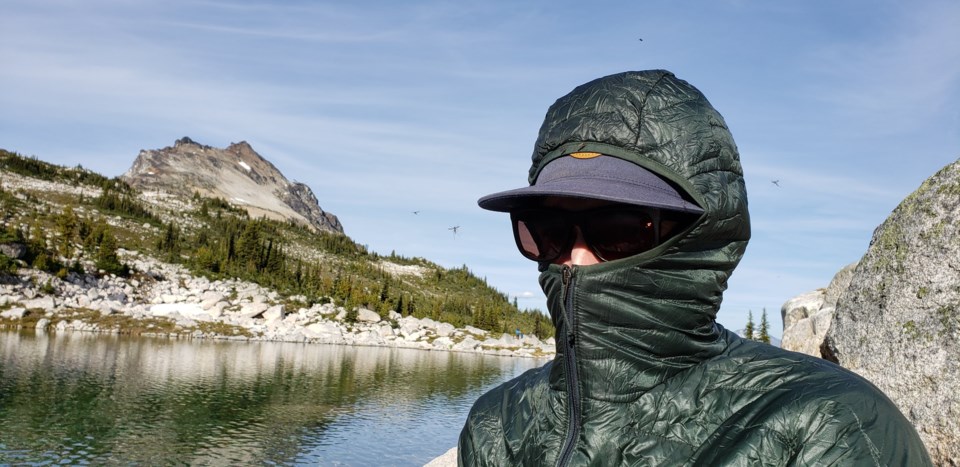A few weeks ago, my partner and I hiked up to an alpine lake to camp for a night. It was during that short heatwave that teased us about summer actually making an appearance this year. Sweaty but thankful for a cool alpine breeze, we set up camp plunged into the icy cold water of the lake before cracking a beer and enjoying the scenery of the Coast Mountain Range.
Sounds heavenly, doesn’t it? It was, until the bugs descended on us.
Swatting constantly at mosquitoes, black flies, midges and what seemed like every possible species of Nematocera, we promptly put our clothes back on and hiked to a nearby ridge, hoping our body motion and a bit more of that alpine breeze might stem the tide of feeding insects. It did, briefly.
On the way back to camp, we crossed paths with another party, all sporting mesh head nets. One of them even had a net that covered her entire upper body. The others were in long pants and sleeves, choosing to suffer the heat rather than the bug bites. We felt a bit underprepared coming all the way up here with nothing but a small bottle of insect repellant. Not about to let the bugs ruin our weekend, we spent the remainder of the evening cooking a nice meal, imbibing another beer and walking over to a viewpoint to catch the last of the golden light hitting the peaks across the valley. I kept my hood up and my sunglasses on as long as I could in order to stop the bugs landing on my eyelids or crawling into my ears and nose. We retreated to the tent, our sanctuary from the vampiric swarms. A few got in as we tried to slip inside the zipper doors, easy swatting targets once they were restricted in their flight paths. We left the fly off the tent so we could fall asleep while gazing upon the stars, a throng of mosquito needles poking through the tiny holes of our meshed shield. I slept uneasily that night, despite having the tent as a barrier. The next morning, they returned with a renewed vigour, swarming us as soon as we exited the tent. We made the call to return back to the car rather than face another day of perforation and hightailed it out of there.
The bugs are bad every summer in Canada, but the rainy spring and late alpine snowmelt has made the 2020 summer particularly bad. So to get us through the next few weeks before the fall frost zaps those little buggers, I took a look at some ways of combating the world’s most annoying insect.
Don the net. Face masks and coverings are all the rage right now, so having mosquito net draped over your head shouldn’t feel too weird. Wearing a ball cap underneath helps keep the mesh off your face and allows adequate ventilation. Plus they are light, cheap and pack down to almost nothing.
Choose the right clothing. Summer should be about tank tops and shorts, right? That’s what the mosquitoes want you to think! Consider shopping for light and breathable long sleeve shirts and trousers for when bugs are at their peak.
Sick’ em with insecticide. Repellant should already be in your pack next to your sunscreen. But as the trail builders working 10 to 12 hour days in the higher elevation forests will attest, spraying yourself with Off! will only do so much, even if it contains a decent percentage of DEET. The next level of protection is an insecticide called Permethrin, which you can use to treat your clothes and gear (much like treating Gore-Tex with a water repellency solution). It is strong enough to kill bugs instead of just repelling them (that is, do not inhale or have direct contact with your skin), so make sure you follow application directions closely and have a change of clothes to sleep in. Chemical weenies need not apply.
Try a new gadget. There’s every manner of wizzbang devices out there that claim to repel bugs without being surrounded by a cloud of chemicals. The most practical one I found for backcountry use is the Thermacell Backpacker Mosquito Repeller. It connects to a standard camping gas canister and heats a cartridge of naturally-derived repellant to create a 4.5-metre bug-free zone. The reviews are mostly positive, so probably worth the $50 pricetag.
Vince Shuley swears he’ll be ready for the bugs next time. For questions, comments or suggestions for The Outsider, email [email protected] or Instagram @whis_vince.




